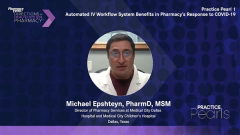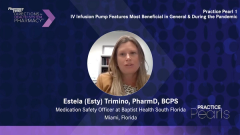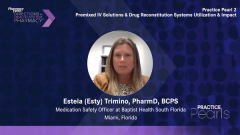
Practice Pearl 1: Implementation Urgency & Pharmacy’s Role in Response to COVID-19
Health-system pharmacists discuss the role pharmacy played within their health-systems in response to COVID-19, and the impact of COVID-19 on implementation urgency.
Episodes in this series

Madeline Camejo, PharmD, MS: Hello and welcome to this Directions in Health System Pharmacy Practice Pearls, “Best Practices for Health Care System Pharmacy During COVID-19.” I am Dr Madeline Camejo, vice president and chief pharmacy officer at Baptist Health South Florida, in Miami. Joining me today virtually are 2 colleagues, Dr Michael Epshteyn, director of pharmacy services at Medical City Dallas Hospital and Medical City Children’s Hospital in Dallas, Texas; and Esty Trimino, medication safety officer at Baptist Health South Florida. Today we’re here to discuss a number of topics pertaining to some of the best practices implemented within our institutions by health system pharmacy to aid in addressing the challenges brought on by COVID-19. Let’s get started guys. One of the first questions I’d like to ask of Michael is, what role did pharmacy play within your health system in response to COVID-19?
Michael Epshteyn, PharmD, MSM: Health system pharmacy is playing a key role in any new developments in therapeutics, and with COVID-19 rapidly emerging in the beginning of 2020, pharmacy had to adapt and come up with new methods and methodologies to evaluate available COVID-19 treatment options. We know we’ve gone through many different options from Plaquenil [hydroxychloroquine] and on and on. We’ve been reviewing available literature and making the best decisions as far as which medications have been proven to be helpful. More so than ever it was important to work in collaboration with the entire health care team, including physicians, nurses, infection prevention and pharmacy networking. Then once those emergent therapies were implemented, the role of pharmacy was to procure the medications, make sure they’re stored in the right conditions, and also create order sets and protocols to make sure that the medications are used as intended in the most safe and effective manner. The pharmacy excelled in that regard by implementing protocols for remdesivir on an inpatient basis and for monoclonal antibody infusions in the outpatient basis, which is not always something that institutional pharmacy would be involved with. We had to adapt, implement, and stay on top of things. That’s really what the previous 12 to 14 months have been for health system pharmacy.
Madeline Camejo, PharmD, MS: Michael, did you have infusion suites where you could convert some of those patients to bamlanivimab, because a lot of times the emergency departments [ED] were full? Trying to do the infusion of bamlanivimab was difficult in the ED. How did you solve that problem, because I know that was a struggle for us?
Michael Epshteyn, PharmD, MSM: That’s a great question, and we do have outpatient infusion set up. But we did repurpose one of the outpatient clinics that was no longer functional and repurposed it into a dedicated infusion space for bamlanivimab, especially considering that all those patients were confirmed COVID-19 positive. You are correct, it’s a big challenge to have the right balancing act of making sure you provide these lifesaving, hospitalization-preventing treatments to help patients with risk factors to get well soon and avoid complications, but also grouping them together and not exposing them to the rest of the population that usually comes to the infusion clinic. Most of the patients who would normally come to your home infusion would be immunocompromised individuals with arthritis, oncology patients, transplant patients. It was important for us that the monoclonal antibody infusion clinic was set up in a completely different space, a different environment, and is dedicated to that type of population specifically.
Madeline Camejo, PharmD, MS: We found the same thing. One of the things we ended up doing isconverting one of our infusion centers to only do bamlanivimab, so that we could group those patients with COVID-19 and not expose them to a lot of our other very sick patients who would normally come see us in the infusion room. Changing operation, changing things, making things different, we had to do a lot of work with making sure things were safe from that perspective. It took our infection control pharmacist and us working with a lot of those people, also the safety officers, to make sure everyone was safe and we could keep patients from getting contaminated with COVID-19. It was a challenge. Esty, I want to ask you, can you discuss the impact of COVID-19 and the implementation of urgency of how quickly things had to change in a safe manner?
Estela (Esty) Trimino, PharmD, BCPS: Yes, to Michael’s point, these last months have impacted us. We changed in days, minutes, hours. But from protocols being established and order sets and medications being put into our system, we had a lot of interdisciplinary help with our nursing teams and our physicians in implementing these protocols quickly. We had emergency P and T [pharmacy and therapeutics] meetings, work groups to have these order sets created in a timely fashion. We worked with our IT [information technology] department to create these and have them available in a timely fashion. We had some challenges, for example, one night we had something come out overnight, and then the next day we were implementing these and creating them and going through these order sets and looking at, if you go from an EUA [emergency use authorization], how do we establish this and document lot numbers? We had a lot of those types setup requirements that were needed and background work as far as having that information available. And we were limited at times to what we had. Every time we would get information, we’d have those come out. It was a collaboration effort. We were lucky for some of these IV [intravenous] infusions that were coming out for COVID-19 that we had wireless capability so we were able to download some of these drugs into our library to have those safety features available for nursing. We also had a lot of workflow in our software where we would create safety features to be implemented, such as if these medications were refrigerated or nonrefrigerated and where we stored them. There were a lot of different processes that were implemented very rapidly.
Transcript edited for clarity.
Newsletter
Stay informed on drug updates, treatment guidelines, and pharmacy practice trends—subscribe to Pharmacy Times for weekly clinical insights.


























































































































































































































